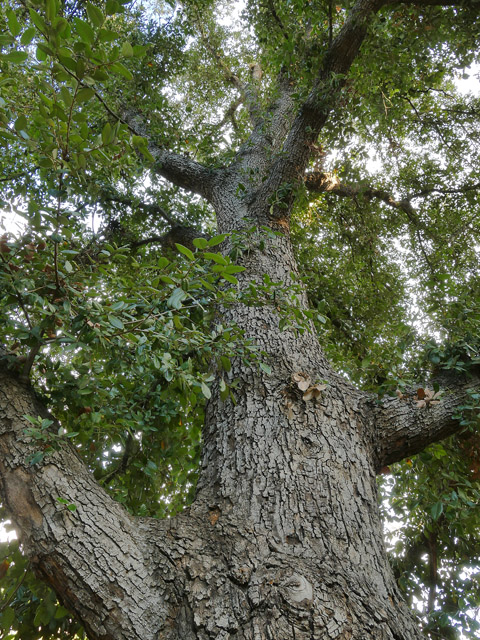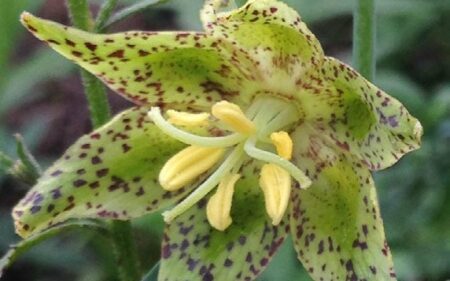Oaks of Santa Barbara Botanic Garden’s Living Collection

Have you ever appreciated the shade of a towering oak tree on a hot day? Or enjoyed watching the flash of black and white and red as a busy Acorn Woodpecker stores food for winter?
Oak trees are an iconic part of landscapes across California.

Anywhere you travel in California you will find oaks: from the stunning blue oak (Quercus douglasii) woodlands in the foothills of the Sierra Nevada, to the Tucker’s oaks (Quercus john-tuckeri) looking out over the Mojave Desert, or the shady groves of coast live oak (Quercus agrifolia) right here in Mission Canyon. There are around 50 species of oak that are native to California, found in almost every habitat type. Around a fifth of those are rare and threatened, generally due to habitat loss or human-introduced pathogens such as Sudden Oak Death (Phytophthora). Their disappearance from the landscape is keenly felt, by humans and wildlife alike.
Reflecting their status as keystone species, oaks are a critical part of Santa Barbara Botanic Garden’s Living Collection. The trees here in the Garden do double duty: in addition to supporting wildlife and humans, the trees in our collection are also an important conservation tool. Acorns are large seeds with a high fat content. These types of seeds are referred to by researchers as “recalcitrant” since these properties make them difficult to store in a seedbank. For this reason, oak trees must be conserved in the wild or in the living collections of botanic gardens. Botanic Gardens Conservation International (BGCI) has created networks of gardens across the world to help address the conservation needs for oaks, and our oaks here at the Santa Barbara Botanic Garden are part of that network.
Our Living Collection of oak trees is a marvel. In our collection we have 27 species of which 6 are considered rare or threatened. Here is a brief virtual tour of just a few of the special oaks that give so much life to our Garden.
Canyon dwellers: coast live oak (Quercus agrifolia) and Nuttall’s scrub oak (Quercus dumosa)


Many of the largest coast live oak trees (Quercus agrifolia) in the garden are likely spontaneous plants from the population native to Mission Canyon. These towering trees are bursting with life, from woodpeckers and squirrels to gall wasps and caterpillars. You may have noticed a lot more coast live oak acorns than usual this year rolling along the Garden’s paths. This excessive production of acorns is called “masting” and it’s a strategy oak trees use to ensure some of their seeds make it to the next generation. When conditions are right, the oak trees will all simultaneously produce extra acorns, which overwhelms any animals that eat them. The birds and squirrels simply can’t keep up, and have to store some for later, thus sowing the seeds of the next mighty oak tree.
The Champion Oak, an Island oak (Quercus tomentella)

Island Oaks can only be found on the Channel Islands off our coast, although fossil evidence suggests that these trees were once widely distributed on the mainland. These rare trees often hybridize with the common canyon oak (Quercus chrysolepis), so preserving the genetic diversity of Island oaks is extremely important. One of our specimens is purported to be the largest island oak in cultivation: it was grown from acorns collected on Santa Cruz Island and planted in in 1966.
Engelmann oak (Quercus engelmannii) from the Ryan Oak Preserve

Engelmann oaks are native to southwestern California and Baja California, Mexico. The San Gabriel Valley was once home to large populations of this species, but suburban expansion destroyed many of them. Frances Beven Ryan grew up at the turn of the 20th century and witnessed this loss in the area around her family’s ranch, but this inspired her to act. She turned her family ranch into a preserve dedicated to the native plants she grew up loving, including the Engelmann oaks. Our specimen came from acorns collected on her preserve in the 1970s, which is now a public park with many of the trees she planted still thriving.
Our Garden is also home to a robust wild population of Nuttall’s scrub oak (Quercus dumosa). Like many chaparral species, this oak is threatened in the wild by development. The wild spaces of the Garden help preserve groves of this special rare tree.
There are so many more species of oaks to discover in the wild places all across California and here in Santa Barbara Botanic Garden. Right now is the perfect time to become an oak aficionado since many of them are producing acorns, so don’t forget to look up!
To explore more oaks in the Garden, please visit our interactive map.
 Donate
Donate




